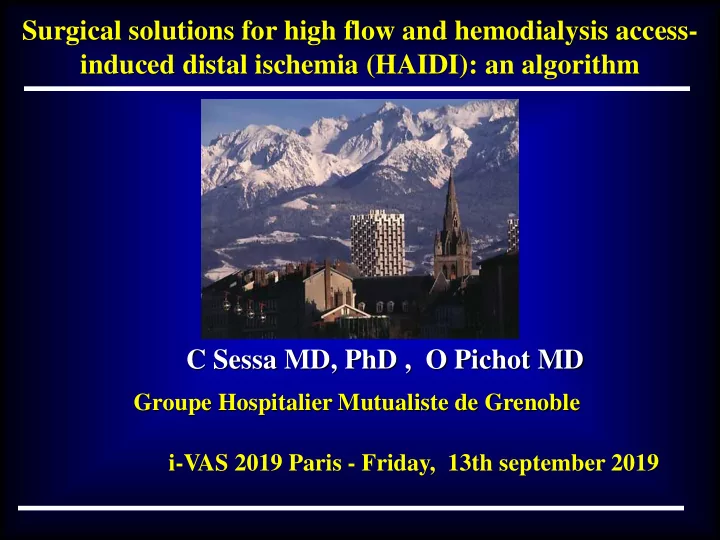

Surgical solutions for high flow and hemodialysis access- induced distal ischemia (HAIDI): an algorithm C Sessa MD, PhD , O Pichot MD Groupe Hospitalier Mutualiste de Grenoble i-VAS 2019 Paris - Friday, 13th september 2019
Hemodynamics of AVF and pathophysiology of hand ischemia Ischemia WITHOUT high flow with high flow (rare) Zanow : 658 ml/min Thermann : 1.38 L/min Sessa : < 1.5 ( L/min (1 case : 2.5 L/min) High flow cardiac symptoms WITHOUT ischemia > 2 L/min with ischemia (rare)
Hemodynamic of hand ischemia Critical points for high flow : above the AVF diameter of artery +++ vein AV anastomosis Critical points for hand ischemia : below the AVF severe distal arteriopathy +++ Wixon 2000 high peripheral resistances lack of collaterals
Introduction Specific techniques for ischemia DRAL : wrist DRI L: wrist, elbow , lower limbs Specific techniques for high flow PRAL : wrist PAVA LIKE technique (personnal technique): elbow Techniques for both Banding : wrist, elbow PAVA or PAI technique : elbow RUDI : elbow
Surgical strategy at the wrist Wrist Patent ulnar artery Forearm and digital with digital arteriopathy arteriopathy * Ligation or embolization of the radial artery Bandings (*) DRIL below the AFV (Storey) (*) specific techniques for hand ischemia
Surgical strategies at the elbow Elbow Normal or high flow Normal flow RUDI (*) DRIL +++ PAVA ou PAI Bandings (*) specific techniques for hand ischemia
The DRIL technique Arterial bypass : > 10 cm above the AFV and immediately below the AVF Increases distal flow to the hand +++ No changes in AVF flow Arterial ligation : right below the AVF Eliminates flow inversion Directs flow in the bypass to the distal arterial network Wixon 2000
The DRIL technique Interval ligation DRIL bypass with great saphenous vein AVF
The Banding techniques What is the « target » ? Which technique is the most appropriate and effective ? Empirical, not well codified, unreproducible How much reduction in needed to decrease flow without compromising the angioaccess ? Is the banding for ischemia different from high flow ? Zanow JVS 2006
Results of Bandings Gupta JVS 2011 87 procedures in 70 patients (Dril , Rudi, Pava…) 22 bandings : higher failure rate : 62% most frequent reason for reintervention : 8/11 (73%)
RUDI (Revision Using Distal Insertion) Lenghtens the fistula to decrease AVF flow Smaller distal artery as inflow Distal anastomosis : 2-3 cm (10-15 cm) below the bifurcation Optimal length and diameter of the conduit ? Callaghan J Vasc Access 2011 7 patients with 3 failures ”a high rate of failure was seen requiring technical modifications and further experience before becoming a valuable technique “
PAVA Proximalization of the arteriovenous anastomosis Proximal inflow from a larger artery to lower arterial pressure drop distal to the AVF mid-brachial artery? axillary artery? What lenght and diameter of the graft ? tapered 4 mm x 7 mm 4 mm or 5 mm PTFE No ligation of the artery vs DRIL No reversed flow to the forearm arteries = DRIL Improvement of distal artery pressure or velocity Zanow
How do I treat ischemia? Wrist : distal radial artery Elbow : ligation (Storey) DRIL
Vascular access ligation Ischemic monomelic neuropathy Severe arterial lesions, poor general conditions or extended tissue loss in patients in whom revascularization is not feasible No improvement of symptoms after revascularization Patients with kidney transplant
High flow : Strategy and techniques of treatment High flow : > 2 L/min Main factors Diameter of artery +++ anastomosis ++ vein Consequences Symptoms of cardiac overload +++ Hand ischemia : rare
High flow : Strategy and techniques of treatment High flow Sessa, Pichot : 2.8 L/min (1.9 - 3.8 L/min ) Indications for flow reduction Cardiac symptoms with flow ≥ 2000 mL/min Asymptomatic patients with flow ≥ 2500 mL/min
Surgical strategies for hand ischemia Wrist Elbow (*) Ligation of the artery Abow the AVF (Bourquelot) RUDI PAVA , PAI (*) PAVA-like technique (personal technique) Banding (*) Transposition of radial artery (Bourquelot) (*) specific techniques for high flow
How do I treat high flow ? Wrist : Proximal radial Elbow : artery ligation PAVA-Like
Authors ’ technique : the PAVA -like PTFE 5 mm x 10 cm for flow < 3 l/min 5 mm x 15 cm for flow > 3 l/min The higher the flow rate, the longer the PTFE graft Mean flow reduction : about 50%
The PAVA-like technique
Conclusions Ischemia and high flow are 2 different situations that require accurate diagnosis and appropriate treatment Specific techniques for ischemia ( DRAL , DRIL) and high flow (PRAL, PAVA LIKE) that are well codified, standardized, reproducible with satisfactory results Other techniques for both situations (PAVA or PAI, banding, RUDI) are not always well codified with “poor” results
Conclusions
Recommend
More recommend